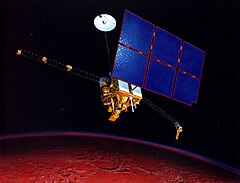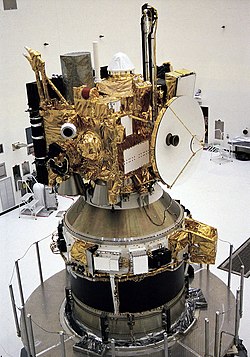Mars Observer
 Mars Observer na orbicie Marsa - wizja artysty | |
| Zaangażowani | |
|---|---|
| Indeks COSPAR | 1992-063A |
| Rakieta nośna | |
| Miejsce startu | |
| Cel misji | |
| Orbita (docelowa, początkowa) | |
| Okrążane ciało niebieskie | |
| Perycentrum | 1,003 j.a. |
| Apocentrum | 1,632 1 j.a. |
| Nachylenie | 1,294° |
| Mimośród | 0,23885 |
| Czas trwania | |
| Początek misji | 25 września 1992 (17:05:01 UTC) |
| Koniec misji | 22 sierpnia 1993 |
| Wymiary | |
| Wymiary | kadłub: 2,1 × 1,5 × 1,1 m |
| Masa całkowita | 2573 kg |
Mars Observer – amerykańska sonda kosmiczna programu Planetary Observer (jedyna misja tego programu wystrzelona w kosmos), która w 1993 roku miała wejść na orbitę Marsa. Misja zakończyła się niepowodzeniem. Z niewyjaśnionych przyczyn 22 sierpnia 1993 o 01:00 UTC stracono z nią łączność. Stało się to w czasie operacji wchodzenia sondy na orbitę okołomarsjańską podczas przygotowań do odpalenia silników głównych. 30 minut po planowanym wykonaniu tego manewru sonda powinna się zgłosić, ale już nigdy się nie odezwała. Wśród prawdopodobnych przyczyn awarii wymieniano m.in. eksplozję materiałów pędnych i wadliwą elektronikę.
Była to pierwsza amerykańska misja na Marsa od czasu sond Viking wystrzelonych w 1975 roku. Mars Observer miał wejść na orbitę polarną o wysokości 378 × 350 km. Przez marsjański rok (687 dni) miał robić zdjęcia powierzchni planety o wysokiej rozdzielczości, badać geologię, atmosferę i klimat, by pogłębić naszą wiedzę na temat ewolucji planet.
Bibliografia
- Misja Mars Observer na stronie NASA. solarsystem.nasa.gov. [zarchiwizowane z tego adresu (2015-05-11)]. (ang.)
- NSSDC Master Catalog (ang.)
Linki zewnętrzne
- Mars Observer na stronie Centrum Lotów Kosmicznych imienia Roberta H. Goddarda (ang.)
Media użyte na tej stronie
In the Payload Hazardous Servicing Facility, the integrated Mars Observer/Transfer Orbit Stage (TOS) payload is ready for encapsulation in the Titan III nose fairing. The TOS booster maiden flight was dedicated to Thomas O. Paine, a former NASA administrator who strongly supported interplanetary exploration and was an early backer of the TOS program. Launched September 25, 1992 from the Kernedy Space Flight Center aboard a Titan III rocket and the TOS, the Mars Observer spacecraft was to be the first U.S. spacecraft to study Mars since the Viking missions 18 years prior. Unfortunately, the Mars Observer spacecraft fell silent just 3 days prior to entering orbit around Mars.
Mars Observer in Mars Orbit showing the solar pannel.
Original Caption Released with NASA Image:



